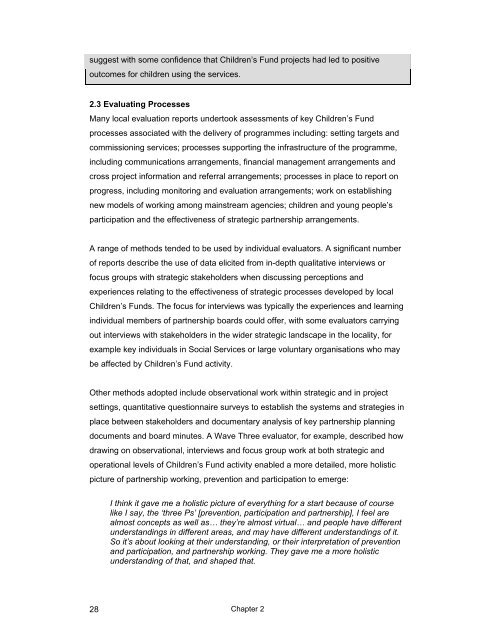Local Evaluation of Children's Services Learning from the Children's ...
Local Evaluation of Children's Services Learning from the Children's ...
Local Evaluation of Children's Services Learning from the Children's ...
- No tags were found...
You also want an ePaper? Increase the reach of your titles
YUMPU automatically turns print PDFs into web optimized ePapers that Google loves.
suggest with some confidence that Children’s Fund projects had led to positiveoutcomes for children using <strong>the</strong> services.2.3 Evaluating ProcessesMany local evaluation reports undertook assessments <strong>of</strong> key Children’s Fundprocesses associated with <strong>the</strong> delivery <strong>of</strong> programmes including: setting targets andcommissioning services; processes supporting <strong>the</strong> infrastructure <strong>of</strong> <strong>the</strong> programme,including communications arrangements, financial management arrangements andcross project information and referral arrangements; processes in place to report onprogress, including monitoring and evaluation arrangements; work on establishingnew models <strong>of</strong> working among mainstream agencies; children and young people’sparticipation and <strong>the</strong> effectiveness <strong>of</strong> strategic partnership arrangements.A range <strong>of</strong> methods tended to be used by individual evaluators. A significant number<strong>of</strong> reports describe <strong>the</strong> use <strong>of</strong> data elicited <strong>from</strong> in-depth qualitative interviews orfocus groups with strategic stakeholders when discussing perceptions andexperiences relating to <strong>the</strong> effectiveness <strong>of</strong> strategic processes developed by localChildren’s Funds. The focus for interviews was typically <strong>the</strong> experiences and learningindividual members <strong>of</strong> partnership boards could <strong>of</strong>fer, with some evaluators carryingout interviews with stakeholders in <strong>the</strong> wider strategic landscape in <strong>the</strong> locality, forexample key individuals in Social <strong>Services</strong> or large voluntary organisations who maybe affected by Children’s Fund activity.O<strong>the</strong>r methods adopted include observational work within strategic and in projectsettings, quantitative questionnaire surveys to establish <strong>the</strong> systems and strategies inplace between stakeholders and documentary analysis <strong>of</strong> key partnership planningdocuments and board minutes. A Wave Three evaluator, for example, described howdrawing on observational, interviews and focus group work at both strategic andoperational levels <strong>of</strong> Children’s Fund activity enabled a more detailed, more holisticpicture <strong>of</strong> partnership working, prevention and participation to emerge:I think it gave me a holistic picture <strong>of</strong> everything for a start because <strong>of</strong> courselike I say, <strong>the</strong> ‘three Ps’ [prevention, participation and partnership], I feel arealmost concepts as well as… <strong>the</strong>y’re almost virtual… and people have differentunderstandings in different areas, and may have different understandings <strong>of</strong> it.So it’s about looking at <strong>the</strong>ir understanding, or <strong>the</strong>ir interpretation <strong>of</strong> preventionand participation, and partnership working. They gave me a more holisticunderstanding <strong>of</strong> that, and shaped that.28Chapter 2
















